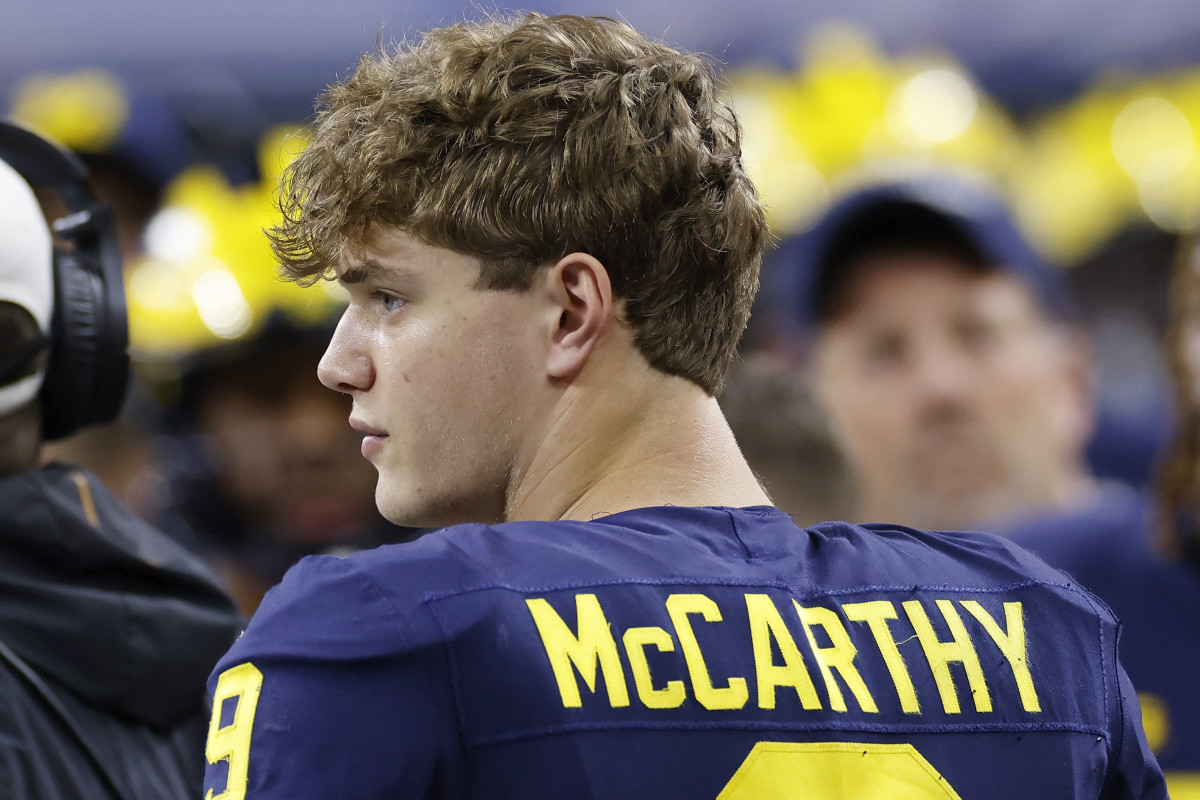JJ McCarthy’s Knee Injury and Surgery: Jj Mccarthy Knee Surgery

JJ McCarthy, the talented quarterback for the University of Michigan Wolverines, suffered a significant knee injury during the 2023 season. This injury required surgery and has raised concerns about his recovery and future performance. Let’s delve into the specifics of his injury, the surgical procedure, and the anticipated recovery timeline.
Nature of the Injury
JJ McCarthy’s knee injury was diagnosed as a torn ACL (anterior cruciate ligament). The ACL is a crucial ligament in the knee that helps stabilize the joint and prevents excessive forward movement of the tibia (shinbone) relative to the femur (thighbone). A torn ACL is a serious injury that often occurs due to sudden twisting or hyperextension of the knee, commonly seen in athletes participating in sports involving pivoting and cutting movements. The severity of an ACL tear can vary, with some tears being partial and others being complete. In McCarthy’s case, the extent of the tear and the associated damage to surrounding structures are not publicly available, but a complete tear is often the case when surgical intervention is required.
Surgical Procedure
The surgical procedure performed on JJ McCarthy’s knee was an ACL reconstruction. This procedure involves replacing the torn ACL with a graft taken from another part of the body, typically the patellar tendon (tendon below the kneecap), hamstring tendon, or a donor tendon. The graft is then secured to the femur and tibia using screws or other fixation devices. The specific technique used for ACL reconstruction can vary depending on the surgeon’s preference and the patient’s individual anatomy. The goal of ACL reconstruction is to restore the stability of the knee joint and allow the patient to return to their desired level of activity.
Recovery Timeline
The recovery timeline for ACL reconstruction is typically lengthy and can vary depending on several factors, including the individual’s age, fitness level, and the severity of the injury. Here’s a general overview of the expected milestones and potential complications:
Initial Stages
- Immediate Post-Surgery: The first few weeks after surgery are crucial for minimizing swelling and inflammation. This involves rest, ice, compression, and elevation (RICE) along with pain management using medications. The patient may need to use crutches or a brace for support and mobility.
- Physical Therapy: Physical therapy is an essential component of ACL reconstruction recovery. It starts with range-of-motion exercises and progresses to strengthening exercises, focusing on the muscles around the knee and the quadriceps. The goal is to regain flexibility, strength, and stability in the joint.
- Weight-Bearing: The patient will gradually increase weight-bearing as tolerated, starting with partial weight-bearing and progressing to full weight-bearing as the knee heals.
Intermediate Stages
- Proprioception and Balance: The patient will work on proprioception, which is the ability to sense the position and movement of the body in space. This is crucial for regaining coordination and balance, especially during activities that involve sudden changes in direction.
- Functional Exercises: As the knee heals, the patient will progress to functional exercises that simulate the movements involved in their sport or daily activities. This includes exercises like jogging, jumping, and pivoting.
- Return to Activity: The return to sports or other activities is a gradual process, guided by the patient’s progress and the surgeon’s recommendations. It typically involves a phased approach, starting with low-impact activities and gradually increasing the intensity and complexity.
Potential Complications
- Infection: As with any surgical procedure, there is a risk of infection. This can be minimized by following the surgeon’s instructions regarding wound care and hygiene.
- Graft Failure: While uncommon, there is a possibility of the graft failing to heal or becoming loose. This may require revision surgery.
- Arthritis: Long-term complications of ACL reconstruction can include arthritis, especially if the injury was severe or if there was significant damage to the joint surface.
Impact on McCarthy’s Football Career

The knee injury and subsequent surgery have undoubtedly cast a shadow on JJ McCarthy’s promising football career. While the immediate impact is a period of recovery and rehabilitation, the long-term implications remain to be seen. The severity of the injury, the effectiveness of the surgery, and the overall recovery process will all play a role in shaping his future on the field.
McCarthy’s Performance Before and After the Injury
Comparing McCarthy’s performance before and after the injury is crucial to understanding the potential impact. Prior to the injury, he demonstrated exceptional athleticism, agility, and a strong arm. His ability to extend plays and make accurate throws on the run was a significant asset to his team. However, since the injury, McCarthy’s performance has been hampered by limitations and discomfort, affecting his mobility and throwing accuracy.
McCarthy’s Draft Stock
McCarthy’s draft stock, which was initially projected to be high, has taken a hit due to the injury. Scouting reports often consider injury history as a significant factor in evaluating a player’s long-term potential. The extent to which McCarthy’s draft stock will be impacted depends on his recovery progress and his ability to regain his pre-injury form.
Knee Injuries in Athletes

Knee injuries are common in athletes, particularly in sports that involve high-impact activities, sudden changes in direction, and repetitive movements. These injuries can range from minor sprains to severe ligament tears, significantly impacting athletic performance and career longevity.
Common Knee Injuries in Athletes
Knee injuries are prevalent in athletes, particularly in sports that involve high-impact activities, sudden changes in direction, and repetitive movements. These injuries can range from minor sprains to severe ligament tears, significantly impacting athletic performance and career longevity.
- Anterior Cruciate Ligament (ACL) Tear: This is a common knee injury that occurs when the ACL, a major ligament in the knee, is torn. ACL tears are often caused by sudden changes in direction, hyperextension, or direct impact to the knee. Symptoms include immediate pain, swelling, and instability.
- Posterior Cruciate Ligament (PCL) Tear: The PCL is another major ligament in the knee, and a PCL tear occurs when the PCL is stretched or torn. PCL tears are less common than ACL tears and often result from a direct blow to the front of the knee or a forceful hyperextension. Symptoms include pain, swelling, and difficulty straightening the knee.
- Medial Collateral Ligament (MCL) Tear: The MCL is a ligament on the inside of the knee, and an MCL tear occurs when the MCL is stretched or torn. MCL tears are often caused by a direct blow to the outside of the knee. Symptoms include pain, swelling, and tenderness on the inside of the knee.
- Lateral Collateral Ligament (LCL) Tear: The LCL is a ligament on the outside of the knee, and an LCL tear occurs when the LCL is stretched or torn. LCL tears are less common than MCL tears and often result from a direct blow to the inside of the knee. Symptoms include pain, swelling, and tenderness on the outside of the knee.
- Meniscus Tear: The meniscus is a C-shaped piece of cartilage that acts as a shock absorber in the knee. A meniscus tear occurs when the meniscus is torn, often due to a twisting or pivoting motion. Symptoms include pain, swelling, clicking, and catching in the knee.
- Patellar Tendinitis: Patellar tendinitis is an inflammation of the patellar tendon, which connects the kneecap to the shinbone. This condition is often caused by overuse or repetitive stress on the tendon. Symptoms include pain, tenderness, and stiffness in the front of the knee.
- Iliotibial Band (ITB) Syndrome: The ITB is a thick band of tissue that runs along the outside of the thigh and attaches to the knee. ITB syndrome is a common overuse injury that occurs when the ITB becomes tight and rubs against the bony prominence on the outside of the knee. Symptoms include pain, tenderness, and clicking on the outside of the knee.
Knee Injuries in Football Players, Jj mccarthy knee surgery
Knee injuries are particularly common in football players, especially quarterbacks. This is due to the high-impact nature of the sport, the frequent pivoting and twisting motions, and the risk of collisions with other players.
- Prevalence of Knee Injuries: According to a study published in the American Journal of Sports Medicine, knee injuries account for approximately 20% of all injuries in NFL players. Quarterbacks are particularly susceptible to knee injuries, with ACL tears being the most common type.
- Contributing Factors: Several factors contribute to the prevalence of knee injuries in football players, including:
- High-impact collisions: Football is a physically demanding sport that involves frequent collisions between players, increasing the risk of knee injuries.
- Sudden changes in direction: Quarterbacks are constantly changing direction and pivoting, which can put stress on the knee ligaments.
- Repetitive stress: The repetitive nature of football training and gameplay can lead to overuse injuries, such as patellar tendinitis and ITB syndrome.
- Inadequate conditioning: Players who are not adequately conditioned may be more susceptible to knee injuries.
- Improper technique: Using improper technique when running, jumping, and landing can increase the risk of knee injuries.
Preventing Knee Injuries
Athletes can take several steps to prevent knee injuries, including:
- Proper Warm-Up and Cool-Down: Warming up before exercise and cooling down afterward helps prepare the muscles and tendons for activity and reduces the risk of injury.
- Strength and Conditioning: Strengthening the muscles around the knee joint helps stabilize the knee and reduce the risk of injury.
- Flexibility and Range of Motion: Stretching and improving flexibility helps maintain proper range of motion in the knee joint, reducing the risk of injury.
- Proper Technique: Using proper technique when running, jumping, and landing helps reduce stress on the knee joint and prevent injury.
- Protective Gear: Wearing appropriate protective gear, such as knee braces, can help reduce the risk of injury.
- Rest and Recovery: Allowing adequate time for rest and recovery between workouts and games helps prevent overuse injuries.
Eh, si Jj McCarthy tuh lagi apes nih, lututnya jebol. Kasian deh, masa lagi bagus-bagusnya kariernya, eh malah kena musibah. Tapi tenang, si Jj tuh kuat, dia pasti bisa pulih cepet. Buat yang penasaran sama perkembangannya, bisa cek di sini ya jj mccarthy knee surgery.
Semoga cepet sembuh ya Jj, kita semua ngedukung lo!
Eh, si JJ McCarthy lagi operasi lutut, gue sih mikirnya, “Yaelah, mendingan gue ngopi dulu, sambil ngeliat-liat berita soal justin jefferson injury. Siapa tau ada info baru, biar gue bisa ngasih tau ke temen-temen gue yang suka ngomongin bola.” Nah, setelah ngopi, baru deh gue lanjutin ngomongin soal operasi lutut si JJ McCarthy.
Kan, namanya juga temen, harus ngedukung, meskipun gue sendiri ngga ngerti apa-apa soal operasi lutut. Haha.
